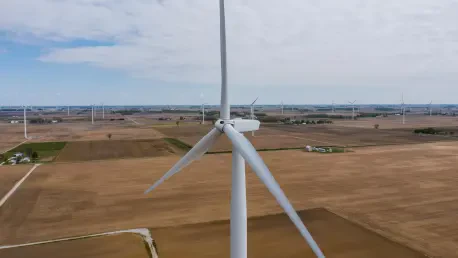What if the backbone of American energy no longer rested on fossil fuels, but on the boundless potential of sun and wind? In the first five months of this year, an astonishing 91% of new electricity capacity added across the United States came from renewable sources, marking a historic shift in how the nation generates power. This isn’t just a fleeting milestone—it’s a glimpse into a future where clean energy drives homes, industries, and innovation. The surge, led by solar and wind, reflects a profound transformation, one that challenges old paradigms and promises a more sustainable path forward. Let’s explore the forces behind this revolution and what it means for the country’s energy landscape.
Why 91% Is a Game-Changer for American Energy
This staggering figure—91% of new capacity from renewables—signals a tipping point in the nation’s energy sector. Over 15 gigawatts (GW) of new electricity generation capacity were added from January to May, with solar and wind overwhelmingly leading the charge. This shift isn’t merely about numbers; it represents a fundamental reimagining of power generation, moving away from carbon-heavy sources toward cleaner, more resilient alternatives. The implications ripple beyond utility grids, influencing policy, economics, and environmental goals on a national scale.
The significance lies in the speed and scale of this transition. For decades, fossil fuels like coal and natural gas dominated energy additions, but now renewables are rewriting the script. This rapid pivot highlights a growing consensus among stakeholders that clean energy is not just viable but essential. It’s a clear indicator that market forces, technological advancements, and societal demand are aligning to prioritize sustainability over traditional energy models.
The National Push for Renewable Energy Growth
Behind this renewable boom lies a convergence of urgent needs: skyrocketing energy demand, the drive to cut greenhouse gas emissions, and the quest for energy independence. As the population grows and industries expand, the call for affordable, reliable power has never been louder. Renewables, with their plummeting costs and scalability, are stepping up to meet these challenges, offering solutions that fossil fuels can no longer match in terms of long-term value or environmental impact.
Public and private sectors alike are rallying behind this cause. Government incentives, though recently scaled back, have historically fueled growth, while corporate commitments to carbon neutrality push demand for green power even higher. This collective momentum underscores a broader recognition that transitioning to renewables isn’t just an environmental imperative—it’s an economic and strategic one, positioning the country to lead in a global clean energy economy.
Unpacking the DatSolar and Wind Lead the Charge
Diving into the specifics, the numbers paint a vivid picture of renewable dominance. Of the 15 GW of new capacity added in early 2025, solar accounted for a massive 11.5 GW, maintaining its top spot for 21 straight months, while wind contributed 2.3 GW. In contrast, natural gas additions were a mere 1.3 GW, a stark reminder of how far the balance has tilted. Looking ahead, projections from the Federal Energy Regulatory Commission (FERC) suggest that 84% of the 133 GW of “high probability” capacity expected by 2028 will be renewable, with solar at 90 GW and wind at 23 GW.
These figures aren’t just about new installations—they reflect a deeper shift in the energy mix. Renewables now make up 32% of total utility-scale capacity in the U.S., a share that could climb further if small-scale solar systems, often untracked, are factored in. This data reveals a grid increasingly shaped by clean energy, challenging the long-standing dominance of natural gas, which still holds 43% of total capacity but is losing ground in new additions.
Industry Insights: Experts on the Renewable Surge
Beyond the statistics, voices from the field provide critical context to this energy shift. Stephanie Bosh of the Solar Energy Industries Association (SEIA) captures the essence of solar’s appeal, stating, “Solar delivers power to the grid faster and cheaper than any other source.” Her words echo a widespread sentiment that cost and speed are driving public and industry preference for renewables over traditional alternatives.
Meanwhile, advocacy groups highlight the gaps in current data. Representatives from the Sun Day campaign argue that FERC’s numbers underrepresent the true scope of renewable impact, estimating that including small-scale solar could push the combined share of solar and wind past 25% of total capacity. These insights, paired with FERC’s objective analysis, suggest that despite policy setbacks—such as the recent elimination of tax credits—market dynamics and innovation continue to propel the renewable sector forward with remarkable resilience.
Sustaining the Momentum: Strategies for a Renewable Future
Maintaining this unprecedented growth requires strategic action amid evolving challenges. Grid modernization stands as a top priority, with projects like the 244 miles of new transmission lines completed this year, including high-voltage lines in Colorado, demonstrating how infrastructure can support renewable integration. Upgrading the grid to handle variable energy sources like solar and wind is essential to prevent bottlenecks and ensure reliability.
Policy advocacy also plays a crucial role. Restoring incentives and dismantling barriers, such as stop-work orders on wind projects or restrictive regulatory guidance, could keep projects on track. Additionally, enhancing data transparency by expanding FERC’s reporting to include small-scale systems and emerging storage technologies like batteries would provide a clearer picture of renewable contributions. These steps, taken together, offer a roadmap for stakeholders to build on the current 91% benchmark and secure a lasting clean energy legacy.
Reflecting on a Historic Shift
Looking back, the early months of this year marked a defining moment in the journey toward a cleaner energy landscape. The dominance of renewables in new capacity additions stood as a testament to years of innovation, investment, and determination. Solar and wind didn’t just outpace other sources—they redefined what was possible, proving that sustainable power could meet the nation’s growing needs.
As this transformation unfolded, the path ahead became clearer with each gigawatt added. Policymakers, businesses, and communities now face the task of accelerating grid upgrades to match renewable growth. Investments in storage solutions must ramp up to balance supply and demand. Above all, a renewed commitment to supportive policies could ensure that this momentum doesn’t falter. The foundation has been laid—building on it is the next great challenge.









